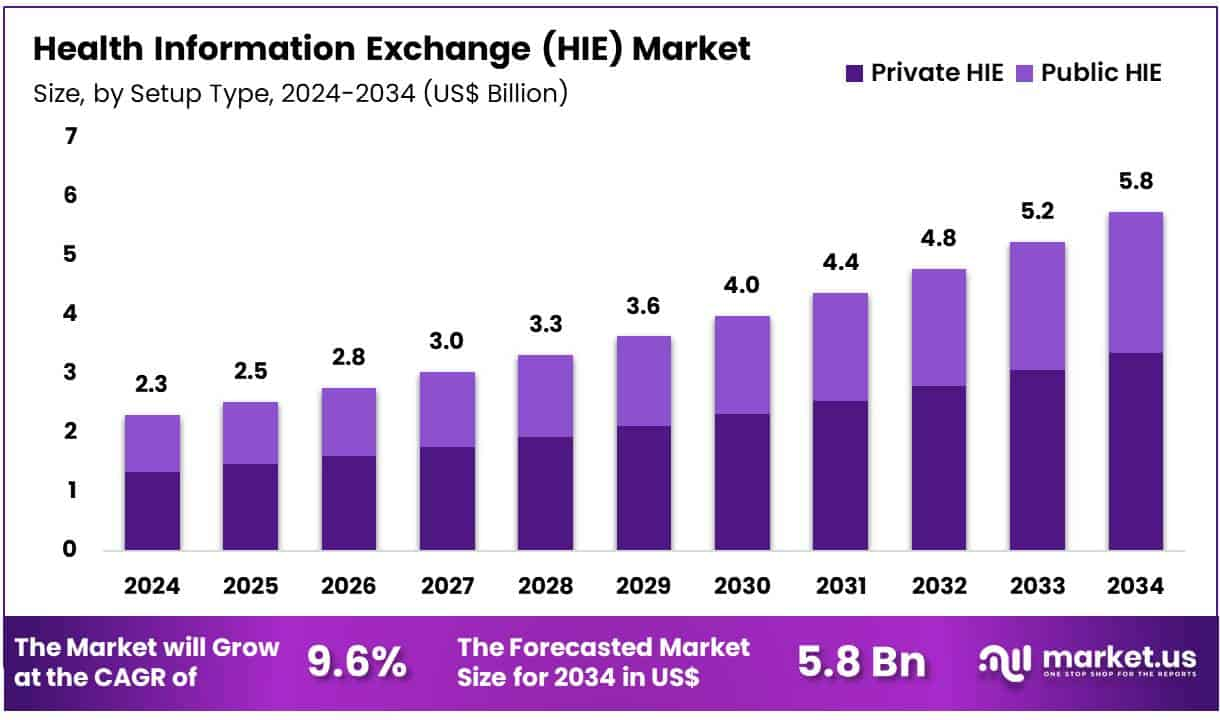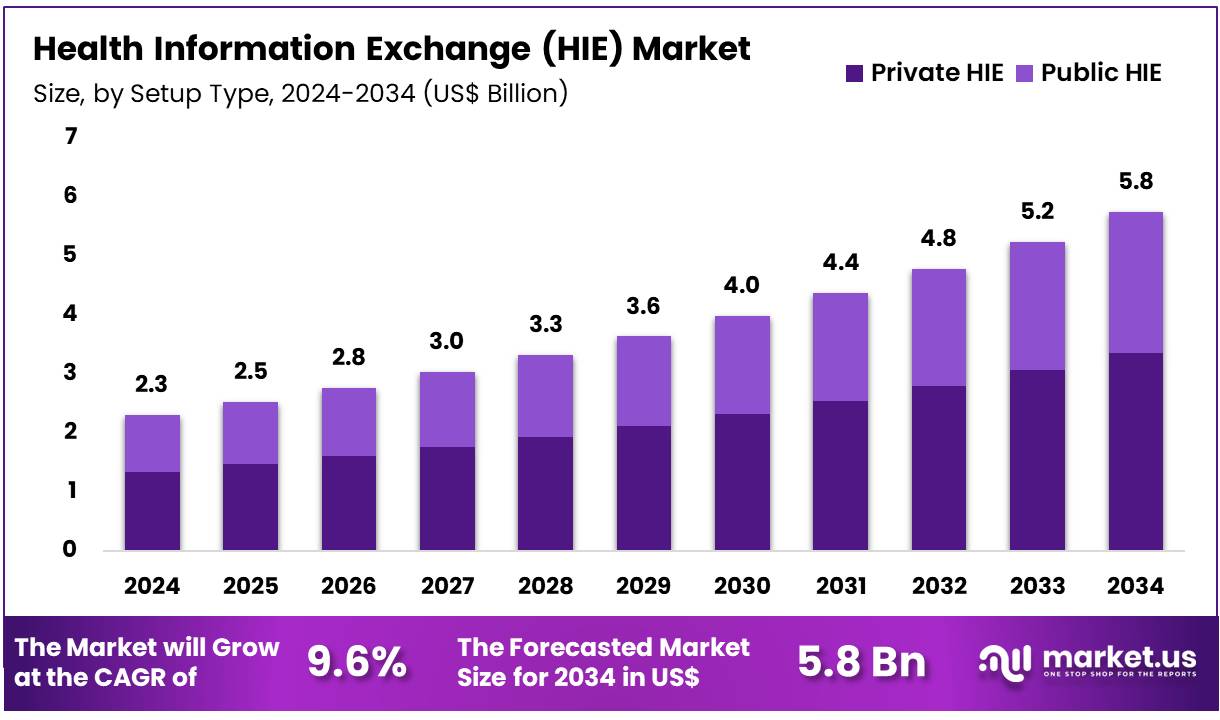Health Information Exchange (HIE) Market Climbs With Innovations in Digital Health Tech

The global Health Information Exchange (HIE) market is projected to grow from USD 2.3 billion in 2024 to around USD 5.8 billion by 2034, at a CAGR of 9.6%. In 2024, North America led the market with a 37.9% revenue share, valued at USD 0.9 billion. This growth is largely due to the increasing demand for efficient and secure health data exchange. HIE systems enable hospitals, clinics, and labs to share patient information safely, improving care coordination and reducing medical errors.
Government initiatives are a major driver of HIE market expansion. In the United States, the Office of the National Coordinator for Health Information Technology (ONC) promotes data sharing through programs like the Trusted Exchange Framework and Common Agreement (TEFCA). These programs aim to enhance interoperability and push healthcare providers to adopt electronic health records (EHRs). Similarly, in Europe, the European Health Data Space initiative supports cross-border health data sharing for better healthcare delivery and research. Cybersecurity has become a top priority as digital health systems expand. HIE platforms now integrate advanced security features like encryption and access controls to protect patient data.
The COVID-19 pandemic highlighted the value of real-time health data exchange. Governments used digital tools to track infections, manage vaccination programs, and monitor patient outcomes. The World Health Organization (WHO) stressed the need for strong health information systems during emergencies. This experience reinforced the importance of HIE systems for better preparedness and response in public health crises. Rising healthcare costs are also encouraging adoption of HIE platforms.

Key Takeaways
- In 2024, the global health information exchange (HIE) market generated US$ 2.3 billion, projected to hit US$ 5.8 billion by 2034.
- The market is expected to grow at a compound annual growth rate (CAGR) of 9.6% throughout the forecast period from 2025 to 2034.
- Directed exchange dominated the type segment in 2023, capturing a leading market share of 47.6% due to efficient provider-to-provider data sharing.
- Among setup types, private health information exchanges led with 58.3% market share, reflecting higher demand for secure, custom-built exchange networks.
- Within applications, web portal development emerged as the top segment, holding the largest revenue share of 36.2% in the HIE market.
- The hybrid implementation model was the most preferred, accounting for 52.8% of the market, blending centralized and decentralized system advantages.
- North America held the dominant regional share in 2023, capturing 37.9% of the market due to strong healthcare infrastructure and policy support.
GET SAMPLE REPORT : https://market.us/report/health-information-exchange-hie-market/request-sample/
Regional Analysis
North America holds the largest share in the Health Information Exchange (HIE) market, accounting for 37.9% of total revenue. This is mainly due to strong government support for interoperability and digital health initiatives. The Office of the National Coordinator for Health Information Technology (ONC) plays a key role. It supports health data exchange through policies, grants, and programs. These federal efforts help providers share data more efficiently, improving both clinical decisions and patient outcomes across the region.
Federal policies such as the 21st Century Cures Act further support market growth. This act mandates the use of open APIs, allowing easier access to patient health data. It encourages developers to create interoperable solutions. As a result, hospitals and clinics can now exchange patient data with external providers more effectively. The ONC's 2024 report highlights a sharp increase in electronic data sharing across U.S. healthcare institutions. This momentum is fueling broader adoption of HIE platforms nationwide.
Improving care coordination remains a central goal in North America’s HIE market. Hospitals, insurers, and other stakeholders are investing in tools that reduce data silos. These systems help share test results, diagnoses, and prescriptions in real time. Better data sharing translates into faster and safer care delivery. The combination of funding, policy mandates, and growing awareness of data interoperability continues to strengthen North America's position in this sector. The region is expected to maintain its lead during the forecast period. In contrast, the Asia Pacific region is projected to register the fastest growth in the coming years.
Governments in countries like India, Australia, and Singapore are advancing digital healthcare agendas. These include national EHR systems, telehealth expansion, and eHealth infrastructure investments. A growing need for better data exchange is pushing healthcare organizations to adopt HIE systems. Strong policy backing and rising healthcare demands are expected to drive high adoption rates and market growth in Asia Pacific through 2034.
Conclusion
In conclusion, the Health Information Exchange market is growing steadily as healthcare systems worldwide move toward safer, faster, and more connected care. The rise of digital tools, government support, and the push for patient-centered care are driving this change. Hospitals and clinics are using HIE platforms to share patient data more easily, which improves treatment and reduces errors. Cloud-based systems, AI integration, and stronger data security are making HIE platforms more reliable and efficient. As healthcare costs rise and data privacy becomes more important, the need for secure and seamless data exchange will continue to grow. Overall, HIE is becoming a key part of modern healthcare infrastructure.
- Art
- Causes
- Crafts
- Dance
- Drinks
- Film
- Fitness
- Food
- Giochi
- Gardening
- Health
- Home
- Literature
- Musica
- Networking
- Altre informazioni
- Party
- Religion
- Shopping
- Sports
- Theater
- Wellness


